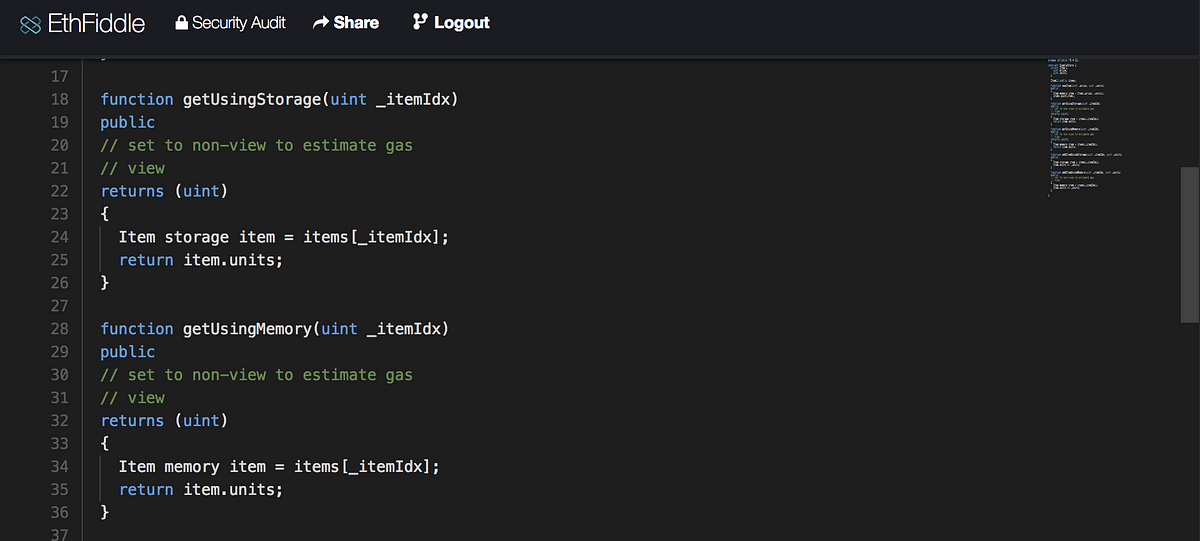Solidity Memory Keyword Explained: Ethereum Variables In-Depth
Learn how the "memory" keyword in Ethereum Solidity determines data storage location and its impact on smart contract functionality and gas costs.
Learn how the "memory" keyword in Ethereum Solidity determines data storage location and its impact on smart contract functionality and gas costs.
In Solidity, understanding where your data lives is crucial for writing efficient and secure smart contracts. You have two primary places to store data: storage and memory. Storage is like your contract's hard drive, where data persists even after a function call ends. Memory, on the other hand, is like RAM - it's temporary and fast, but the data disappears once the function execution is complete.
In Solidity, you have different places to store data. Think of storage like a hard drive - it's permanent. Memory is like RAM - temporary and fast.
contract Example {
// Storage - persists
uint256 storedData = 10;
function getStoredData() public view returns (uint256) {
return storedData;
}
function changeStoredData(uint256 newData) public {
storedData = newData;
}
}When you use memory, the data is gone after the function ends.
function add(uint256 a, uint256 b) public pure returns (uint256) {
// Memory - temporary
uint256 result = a + b;
return result;
}Function arguments are usually in memory by default. You can't directly change storage variables from inside a function using memory arguments.
function tryToChange(uint256 newValue) public {
// Won't change the actual storedData!
newValue = 100;
}To modify storage from a function, you need to explicitly use the storage keyword.
function changeStorageDirectly(uint256[] storage data, uint256 index, uint256 newValue) public {
data[index] = newValue;
}Choosing between storage and memory impacts gas costs. Storage is more expensive to write to, while memory is cheaper but temporary.
This Solidity code demonstrates the concepts of storage and memory in a smart contract. It defines a contract named DataStorageExample with examples of storing and retrieving data in storage, performing calculations in memory, and the difference in persistence between the two. The contract showcases how to modify storage variables directly and highlights the gas cost implications of storage versus memory.
pragma solidity ^0.8.0;
contract DataStorageExample {
// Storage - persists like a hard drive
uint256 public storedData = 10;
// Function to read from storage
function getStoredData() public view returns (uint256) {
return storedData;
}
// Function to modify data in storage
function changeStoredData(uint256 newData) public {
storedData = newData;
}
// Function using memory - temporary like RAM
function add(uint256 a, uint256 b) public pure returns (uint256) {
// Memory - temporary
uint256 result = a + b;
return result;
}
// Demonstrating that memory changes don't affect storage
function tryToChange(uint256 newValue) public view returns (uint256){
// Won't change the actual storedData!
newValue = 100;
return newValue; // Returns 100, but storedData remains unchanged
}
// Modifying storage directly using the 'storage' keyword
uint256[] public myArray;
function changeStorageDirectly(uint256 index, uint256 newValue) public {
myArray[index] = newValue;
}
}Explanation:
storedData is declared as a state variable, making it a storage variable.getStoredData() reads and returns the value of storedData.changeStoredData() modifies the value of storedData.add() function demonstrates the use of memory. The result variable is temporary and only exists within the function's scope.tryToChange() highlights that modifying a memory variable does not affect the corresponding storage variable.changeStorageDirectly() shows how to modify a storage variable (in this case, an array) directly using the storage keyword.Key Points:
1. Default Data Locations:
memory for value types (like uint, bool, address).calldata for arrays and structs (unless explicitly declared as memory).2. calldata Keyword:
memory, but read-only and non-modifiable.3. Passing Large Data Structures:
memory can be expensive.calldata for read-only access or passing references to storage locations if modification is needed.4. Security Considerations:
memory for temporary data manipulation to avoid unintended side effects on the contract's state.5. Best Practices:
6. Example of calldata:
function processData(uint[] calldata data) public pure {
// Data is read-only inside the function
uint sum = 0;
for (uint i = 0; i < data.length; i++) {
sum += data[i];
}
// ... use the calculated sum
}| Feature | Storage | Memory |
|---|---|---|
| Persistence | Permanent (like a hard drive) | Temporary (like RAM) |
| Scope | Contract level | Function level |
| Cost | Expensive to write | Cheap to write |
| Example | State variables declared directly in the contract | Variables declared inside functions |
Key Points:
storage keyword.Gas Cost Implications:
Best Practices:
Mastering the distinction between storage and memory is fundamental for Solidity developers. It directly impacts a smart contract's gas efficiency, security, and overall functionality. By carefully choosing where to store data, developers can optimize their contracts for performance and cost-effectiveness. Remember that while storage offers persistence, it comes at a higher gas cost. Memory, on the other hand, provides a temporary but cheaper alternative for data manipulation within functions. Understanding these trade-offs is key to writing efficient and robust smart contracts on the Ethereum blockchain.
 What is the memory keyword in Solidity? | Contributor: Muhammad Ahsan
What is the memory keyword in Solidity? | Contributor: Muhammad Ahsan Ethereum Solidity: Memory vs Storage & When to Use Them | by ... | Differences between
Ethereum Solidity: Memory vs Storage & When to Use Them | by ... | Differences between storage and memory data location keywords. Storage vs Memory in Solidity - GeeksforGeeks | A Computer Science portal for geeks. It contains well written, well thought and well explained computer science and programming articles, quizzes and practice/competitive programming/company interview Questions.
Storage vs Memory in Solidity - GeeksforGeeks | A Computer Science portal for geeks. It contains well written, well thought and well explained computer science and programming articles, quizzes and practice/competitive programming/company interview Questions. What Is the Solidity memory Keyword in Ethereum? - Metaschool | In Solidity, memory is a temporary storage space primarily used for function arguments and local variables.
What Is the Solidity memory Keyword in Ethereum? - Metaschool | In Solidity, memory is a temporary storage space primarily used for function arguments and local variables. Storage and memory secrets in Solidity | Kristaps Grinbergs | This time, we will talk about storage locations in Solidity programming language, specifically about the
Storage and memory secrets in Solidity | Kristaps Grinbergs | This time, we will talk about storage locations in Solidity programming language, specifically about the storage and memory locations. Not knowing what they represent and how they work can cause issues in our smart contracts. When to use Storage vs. Memory vs. Calldata in Solidity | Learn about the different data locations in Solidity and when to them
When to use Storage vs. Memory vs. Calldata in Solidity | Learn about the different data locations in Solidity and when to them